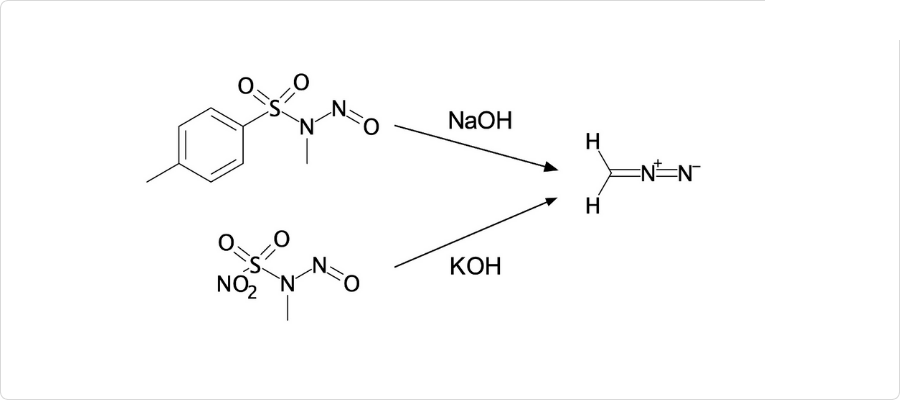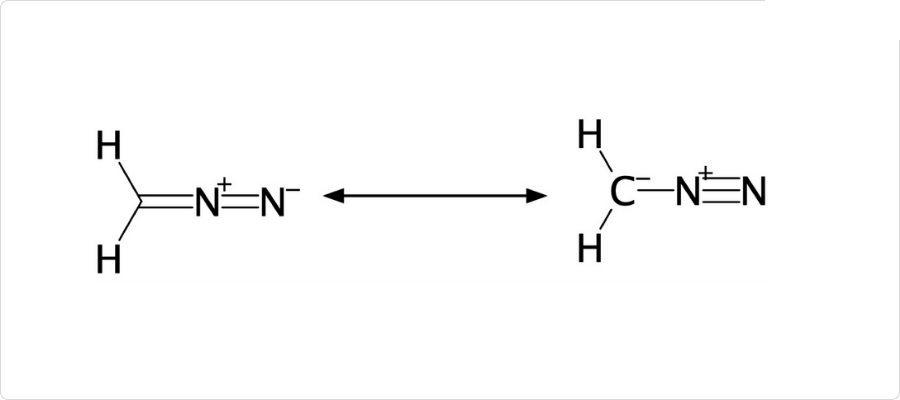-
種類
ジアゾメタンそのものは、非常に不安定で危険な取り扱いにくい物質であるため、市販されていません。前述の通り、通常はエーテル溶液、もしくはジオキサン溶液として用時調整して使用されます。
一方、トリメチルシリルジアゾメタン ((CH3)3SiCHN2) は、ジアゾメタンとほぼ同様な反応性を持つ物質でありながら、爆発性のない安定な液体です。扱いやすいため、化学試薬として一般に市販もされています。
どうしてもジアゾメタンそのものを用いないとならない特別な場合を除いて、一般的にはこちらを用いることが主流であり、安全面からも望ましいとされます。トリメチルシリルジアゾメタンの試薬製品は、通常は10%ヘキサン溶液などの状態です。5mL , 25mL , 100mLなどの種類があり、冷蔵保管が必要な試薬として取り扱われます。
-
解説
CH2N2(42.04).脂肪族ジアゾ化合物.次の二つの構造の間に共鳴している.H2C=N+"=N-": H2C-"-N+"≡N:N-ニトロソメチルウレタンCH3N(NO)COOC2H5,あるいはN-ニトロソ-p-トルエンスルホン酸-N-メチルアミドを水酸化カリウムと処理して生成される.黄色,無臭の非常に有毒な気体.融点-145 ℃,沸点-24 ℃.エーテル,ジオキサンに可溶.カルボン酸やフェノール性ヒドロキシ基のO-メチル化,ケトンのエポキシド化を経由するC-メチル化,そのほかの反応に用いられる.また,ジアゾメタンを光分解するとメチレン遊離基が生成する.濃厚溶液は爆発性があるので,通常,エーテル溶液として使用する.ガラスの粗面は爆発を誘起しやすいため,すり合わせ器具は避けるべきである.[CAS 334-88-3]
森北出版「化学辞典(第2版)
-
用途
メチル化剤、農薬原料、医薬原料
-
合成

図3. ジアゾメタンの合成法
ジアゾメタンは前述の通り爆発性があるため、エーテルまたはジオキサン溶液として用時調整して使用します。アシル化またはスルホン化されたN-メチル-N-ニトロソアミンを濃アルカリ水溶液中と反応させて合成する方法が一般的です。
具体的な実験操作としては下記の流れで得ることができます。
- 濃アルカリ水溶液の上にエーテルないしはジオキサン層を張って二層系ビーカーを用意する。
- 氷冷下攪拌しながらN-メチル-N-ニトロソアミン誘導体を少量ずつ加える。
- エーテル層に発生するジアゾメタンを捕集する。
-
化学的特性
Diazomethane is a flammable, yellow gas or
a liquid under pressure. Musty odor.
-
使用
Powerful methylating agent for acidic Compounds such as carboxylic acids, phenols, enols. For syntheses with diazomethane see the reviews by Smith, Chem. Rev. 23, 193 (1938); Eistert, Z. Angew. Chem. 54, 99, 124 (1941) translated by Spangler in Newer Methods of Preparative Organic Chemistry (New York, 1948) p 513; J. S. Pizey, Synthetic Reagents vol. 2 (John Wiley, New York, 1974) pp 65-142.
-
定義
ChEBI: The simplest diazo compound, in which a diazo group is attached to a methylene group.
-
一般的な説明
Yellow gas with a musty odor. Highly toxic by inhalation Shipped as a liquid under pressure.
-
空気と水の反応
Reacts with water, releasing nitrogen, more stable in ether or dioxane.
-
反応プロフィール
Diazomethane undergoes violent thermal decomposition. Above 200°C. the vapors may explode violently if rough glass surfaces are present. Explosions at low temperatures can occur if traces of organic matter are present. [J. Phys. Chem. 35:1403(1931)]. Produces explosions with alkali metals. Reacts with copper powder and to some extent all solid surfaces to produce nitrogen and solid white polymethylene. Reacts with dimethylaminodimethylarsine and trimethyltin in ether with vigorous foaming.
-
健康ハザード
Diazomethane vapor causes severe irritation of the skin, eyes, mucous membranes,
and lungs. It is considered to be a substance with poor warning properties, and the
effects of exposure may be delayed in onset. Symptoms of exposure may include
headache, chest pain, cough, fever, severe asthmatic attacks, and pulmonary edema,
which can be fatal. Exposure of the skin and mucous membranes to diazomethane
may cause serious burns.
Diazomethane is a powerful allergen. Prolonged or repeated exposure to
diazomethane can lead to sensitization of the skin and lungs, in which case asthma-
like symptoms or fever may occur as the result of exposure to concentrations of
diazomethane that previously caused no symptoms. Chronic exposure to
diazomethane has been reported to cause cancer in experimental animals, but this
substance has not been identified as a human carcinogen.
Note that diazomethane is often prepared in situ from precursors that may
themselves be highly toxic and/or carcinogenic.
-
火災危険
Pure diazomethane gas and liquid are readily flammable and can explode easily. A
variety of conditions have been reported to cause explosions of diazomethane,
including contact with rough surfaces such as ground-glass joints, etched or
scratched flasks, and glass tubing that has not been carefully fire-polished. Direct
sunlight and strong artificial light may also cause explosions of this substance.
Violent reactions may occur on exposure of diazomethane to alkali metals.
-
燃焼性と爆発性
Pure diazomethane gas and liquid are readily flammable and can explode easily. A variety of conditions have been reported to cause explosions of diazomethane, including contact with rough surfaces such as ground-glass joints, etched or scratched flasks, and glass tubing that has not been carefully fire-polished. Direct sunlight and strong artificial light may also cause explosions of this substance. Violent reactions may occur on exposure of diazomethane to alkali metals.
-
化学反応
ジアゾメタンは、光分解によりメチレンCH2を発生する物質です。酸塩化物と反応させると、ジアゾメチルケトンまたはクロロメチルケトンが生成します。
活性なアセチレン類の三重結合やエチレン類の二重結合とは、1,3-双極子付加反応してピラゾール誘導体ないしはピラゾリン誘導体を生成します。また、アーント・アイシュタート合成による環状ケトンの環拡大反応などにも利用される物質です。
フェノールあるいはカルボン酸のO-メチル化剤として汎用される場合、氷冷した過剰量のジアゾメタンのエーテル溶液を攪拌し、フェノールあるいはカルボン酸の溶液にに少量ずつ加えて反応を進行させる実験操作が一般的です。
-
使用用途
ジアゾメタンの主な使用用途には、メチル化剤、農薬原料、医薬原料などがあります。有機合成の実験室では、特に、カルボン酸やフェノール性ヒドロキシ基のO-メチル化 (メチルエーテル誘導体やメチルエステル誘導体を生成する) やケトンのエポキシド化を経由するC-メチル化などの反応に使用されています。
爆発性があるため、通常はエーテル溶液、もしくはジオキサン溶液として用時調整して使用されますが、より安全で扱いやすい代替試薬が用いられることも非常に多いです。
-
安全性プロファイル
Confirmed carcinogen
with experimental tumorigenic data. A
poisonous irritant by inhalation. A powerful
allergen. It can cause pulmonary edema and
frequently causes hypersensitivity leading to
asthmatic symptoms. Mutation data
reported. Highly explosive when shocked,
exposed to heat, or by chemical reaction.
Undiluted liquid or gas may explode on
contact with alkali metals, rough surfaces,
heat (lOO°C), hgh-intensity light, or shock.
When heated to decomposition or on
contact with acid or acid fumes it emits
highly toxic fumes of NOx. Incompatible
with alkali metals; calcium sulfate.
-
職業ばく露
Diazomethane is a powerful methylat-
ing agent for acidic compounds, such as carboxylic acids,
phenols and enols. It is used in pesticide manufacture and
pharmaceutical manufacture.
-
発がん性
Diazomethane was administered
to rats and mice by inhalation, dermal, or subcutaneous
injection routes using concentrations of 0.1 or 3.3 mg/mL.
Mice developed lung tumors following either dermal application
or inhalation at both concentrations.
-
特徴

図2. ジアゾメタンの共鳴構造式
ジアゾメタンはπ電子が非局在化しているため、ルイス構造は共鳴混成体として表現され、分子構造は直線構造です。非常に不安定な物質であるため、前述の通り、衝撃、摩擦、振動を加えると、爆発的に分解することがあります。
100℃への加熱や、粗面との接触も爆発を誘引する因子です。さらに、希釈していない液体や濃縮溶液中に不純物や固体が存在する場合にも、高強度の光の下で爆発することがあります。
-
貯蔵
diazomethane should preferably be handled in solution using glassware specially designated for diazomethane (e.g., with Clear-Seal joints) and should be used as soon as possible after preparation. Storage of diazomethane solutions (even at low temperature) is not advisable. All work with diazomethane should be conducted in a fume hood behind a safety shield, and appropriate impermeable gloves, protective clothing, and safety goggles should be worn at all times.
-
輸送方法
UN1953 Compressed gas, toxic, flammable, n.o.s.
-
不和合性
Heat (at about or above 100
C), shock,
friction, concussion, sunlight, or other intense illuminations
may cause explosions. Contact with alkali metals; drying
agents such as calcium sulfate, or rough edges (such as
ground glass) may cause explosions. Diazo compounds can
detonate. This applies in particular to organic azides that
have been sensitized by the addition of metal salts or strong
acids. Toxic gases are formed by mixing materials of this
class with acids, aldehydes, amides, carbamates, cyanides,
inorganic fluorides, halogenated organics, isocyanates,
ketones, metals, nitrides, peroxides, phenols, epoxides, acyl
halides, and strong oxidizing or reducing agents.
Flammable gases are formed by mixing materials in this
group with alkali metals. Explosive combination can occur
with strong oxidizing agents, metal salts, peroxides, and
sulfides. This chemical is sensitive to prolonged exposure
to heat. This chemical is incompatible with strong
oxidizing agents
.
-
廃棄物の処理
Decompose chemically
with ceric ammonium nitrate under constant agitation and
cooling
.
-
予防処置
Diazomethane is attractive as a methylating agent for carboxylic acids and phenols because it reacts quickly and highly efficiently with the production of only N2 as a by-product (Black, 1983). Its natural yellow color is discharged as it reacts, providing automatic indication of reaction progress. However, because diazomethane is highly toxic, it should be generated and used only in a well-functioning fume hood. Because it explodes on contact with some metals or ground glass of any type (joints, stoppers, syringes, stopcocks), it should be handled behind a safety shield, and other personal protective equipment should be used. Because it has a boiling point of ?23°C, it is usually handled in the ethereal solutions in which it is generated. Because it explodes on contact with CaSO4, its solutions or vapors must never be dried with drierite. Despite all of these hazards, it can be worked with safely, provided that appropriate precautions are observed.



